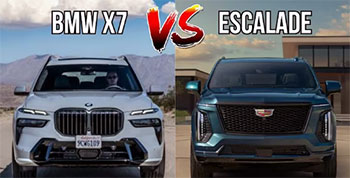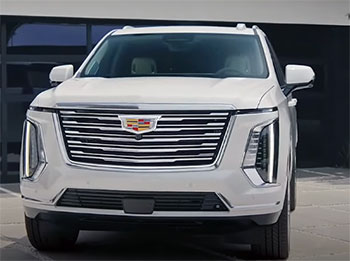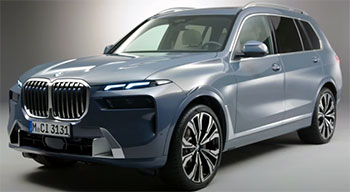I’ve always been fascinated by luxury SUVs—their commanding presence, plush interiors, and the promise of power under the hood. When it came time to choose between the BMW X7 and the Cadillac Escalade, I found myself weighing two titans of the road.
My goal here is to share my experience comparing these vehicles, focusing on their key features, pros, and cons, to help you decide which one fits your lifestyle. From performance to comfort, I’ll break it all down in a way that’s clear and engaging, so you can make an informed choice.
Comparison Table: BMW X7 vs. Cadillac Escalade
| Feature | BMW X7 | Cadillac Escalade |
|---|---|---|
| Starting MSRP | $84,675 | $83,890 |
| Base Engine | 3.0L Turbo Inline-6, 375 hp | 6.2L V8, 420 hp |
| Fuel Economy (City/Hwy) | 21/25 MPG | 14/19 MPG |
| Cargo Capacity (Seats Up) | 12.8 ft³ | 25.5 ft³ |
| Max Cargo Capacity | 90.4 ft³ | 90.4 ft³ |
| Front Legroom | 39.8 in | 44.5 in |
| Second-Row Legroom | 37.6 in | 41.7 in |
| Seating Capacity | Up to 7 | Up to 8 |
| Towing Capacity | Up to 7,500 lbs | Up to 8,200 lbs |
| Infotainment Screen | 14.9-inch touchscreen | 38-inch curved OLED display |
| Standard Safety Features | Forward-collision warning, Lane Departure Warning | Automatic Emergency Braking, Pedestrian Detection |
| Curb Weight | ~5,400 lbs | ~5,856 lbs |
My First Impressions: Style and Presence
Driving through my neighborhood, I wanted a vehicle that turned heads. The Cadillac Escalade, with its bold, angular design and massive chrome grille, screams authority.
It’s like a luxury tank, exuding confidence whether parked at a grocery store or cruising down the highway. At over 211 inches long, it’s a beast that demands attention. I felt like a celebrity just sitting in it.
The BMW X7, on the other hand, takes a more refined approach. Its sleek lines and iconic kidney grille (admittedly polarizing) give it a sophisticated edge. At 203 inches, it’s slightly shorter but feels agile, almost like a sports car masquerading as an SUV. I appreciated its understated elegance, but it didn’t have the same in-your-face bravado as the Escalade.
Performance: Power Meets Precision

As someone who enjoys a spirited drive, I was eager to test how these SUVs handled.
The Escalade’s standard 6.2-liter V8 engine pumps out 420 horsepower and 460 lb-ft of torque.
It’s a powerhouse, perfect for towing my boat to the lake (it handles up to 8,200 pounds).
But the ride? It’s firm, almost jarring on rough roads, especially with those massive 22-inch wheels.
I noticed a constant low-frequency vibration that, while not a dealbreaker, didn’t scream “luxury” on longer trips. Still, its precise steering made it surprisingly nimble for its size, and I felt in control merging onto busy freeways.
The BMW X7, with its base 3.0-liter turbocharged inline-six (375 hp), felt smoother and more composed. For those craving more, the M60i’s twin-turbo V8 delivers 523 hp, outpacing the Escalade’s base engine.
I took the X7 on a winding backroad, and its handling was a revelation—crisp, responsive, almost defying its size. The optional ALPINA XB7 trim, with 612 hp, is overkill for most, but it’s there if you want to flex.
The X7’s lighter weight (about 500 pounds less than the Escalade) and Auto Stop-Start technology made it feel more efficient, sipping fuel at 21/25 MPG compared to the Escalade’s thirsty 14/19 MPG. For my daily commute, the X7’s fuel economy was a clear win.
Interior: Where Luxury Lives

Stepping into the Escalade’s cabin was like entering a tech showcase.
The 38-inch curved OLED display is a jaw-dropper, seamlessly integrating navigation, entertainment, and vehicle stats.
It’s intuitive, though I fumbled a bit with the touch controls at first.
The leather seats were plush, and with 44.5 inches of front legroom and 41.7 inches in the second row, I never felt cramped, even with my tall friends in tow. The third row, however, was tight for adults—better suited for kids or short trips.
Cargo space impressed me, with 25.5 cubic feet behind the third row, perfect for weekend getaways.
The X7’s interior, while equally luxurious, leaned toward elegance over flash. The 14.9-inch touchscreen, paired with a 12.3-inch digital gauge cluster, felt high-tech but less overwhelming than the Escalade’s massive display. I loved the standard four-zone climate control (the Escalade has tri-zone), which let my passengers fine-tune their comfort.
The X7’s seats, wrapped in optional Vernasca leather, were supportive, but the legroom (39.8 inches front, 37.6 inches second row) was noticeably less generous. Cargo space was a letdown at 12.8 cubic feet behind the third row—fine for groceries but not for big family trips. Both SUVs max out at 90.4 cubic feet with the second row folded, but the Escalade’s larger starting capacity gave it an edge for my needs.
Technology: Cutting-Edge Comfort

I’m a bit of a tech nerd, so the gadgets in these SUVs were a big draw.
The Escalade’s Cadillac User Experience (CUE) system is a standout, with crisp graphics and voice-activated controls.
Adaptive Cruise Control, Automatic Emergency Braking, and a Surround-View Camera System made city driving a breeze.
I especially appreciated the semi-autonomous steering on highways—it felt like the future. But some features, like the engine start button, felt cheap for a vehicle of this caliber, a minor but noticeable flaw.
The X7’s iDrive 8 system was equally impressive, with a rotary knob and voice controls that I found more intuitive than the Escalade’s touch-heavy setup. The standard Active Driving Assistant includes pedestrian detection and lane departure warnings, but the optional Driving Assistance Professional Package stole the show.
Its hands-free driving at speeds up to 85 mph, activated by glancing at the side mirrors, felt like something out of a sci-fi movie. The panoramic moonroof and Crystal Headlights added a touch of flair, making every drive feel special.
Safety: Peace of Mind on the Road
Safety is non-negotiable for me, especially with family in the car. Both SUVs come loaded with standard features. The Escalade offers Automatic Emergency Braking, Pedestrian Detection, and a 360-degree camera, which gave me confidence in tight parking lots.
The X7 counters with Forward-Collision Warning, Lane Departure Warning, and Active Blind Spot Detection. Both earned high safety ratings, with the Escalade at 4/5 stars from NHTSA. The X7’s optional package, with features like autonomous collision mitigation, felt a step ahead, but the Escalade’s standard suite was robust enough for most scenarios.
Pros and Cons: Breaking It Down
BMW X7 Pros
- Fuel Efficiency: 21/25 MPG is a big win for long drives and daily commutes.
- Handling: Feels agile and sporty, especially for a large SUV.
- Technology: iDrive 8 and optional hands-free driving are cutting-edge.
- Customization: Multiple engine options, from the efficient inline-six to the beastly ALPINA V8.
- Interior Quality: Elegant design with premium materials and four-zone climate control.
BMW X7 Cons
- Cargo Space: Only 12.8 cubic feet behind the third row, limiting practicality.
- Legroom: Less spacious than the Escalade, especially in the second and third rows.
- Price Creep: Higher trims and options can push the cost well over $100,000.
- Reliability Concerns: Some owners report issues, though my experience was issue-free.
- Polarizing Design: The oversized grille isn’t for everyone.
Cadillac Escalade Pros
- Spacious Interior: Generous legroom and seating for up to eight make it family-friendly.
- Cargo Capacity: 25.5 cubic feet behind the third row is a game-changer.
- Powerful Engine: The V8’s 420 hp and 8,200-pound towing capacity are ideal for heavy loads.
- Bold Styling: Its commanding presence stands out in any setting.
- Advanced Tech: The 38-inch OLED display and semi-autonomous driving are top-notch.
Cadillac Escalade Cons
- Fuel Economy: 14/19 MPG is a budget-buster at the pump.
- Ride Quality: The firm suspension and 22-inch wheels make for a bumpy ride.
- Base Trim Gaps: Some safety and tech features aren’t standard on lower trims.
- Weight: At nearly 6,000 pounds, it feels heavy and less nimble.
- Interior Details: Some elements, like the engine start button, feel less premium.
Driving Experience: Real-World Feel
I took both SUVs on a weekend road trip to test their real-world performance. The Escalade was a beast on the highway, its V8 roaring as I passed slower traffic. Towing my trailer was effortless, but the constant stops for gas were a reminder of its thirst. In the city, parking was a challenge due to its size, though the surround-view camera helped. The ride, however, felt harsh over potholes, and I wished for a softer suspension.
The X7, by contrast, was a joy to drive. Its adaptive suspension soaked up bumps, and the lighter weight made it feel more planted in turns. I barely noticed the fuel gauge dipping, which was a relief. However, loading up for the trip highlighted the cargo space issue—my gear barely fit with the third row up. The X7’s tech, like the hands-free lane changes, made long drives less fatiguing, but I missed the Escalade’s extra legroom for my passengers.
Cost and Value: What’s Worth Your Money?
Price is a big factor for me, and these SUVs are close but tell different stories. The Escalade starts at $83,890, slightly cheaper than the X7’s $84,675. But the Escalade’s higher fuel costs and pricier maintenance (due to its V8 and heavier build) add up over time. The X7’s better fuel economy and lower curb weight make it cheaper to run, and its resale value is slightly better (55% retained after five years vs. the Escalade’s 57.8% depreciation). However, fully loaded X7 models, like the M60i or ALPINA, can soar past $150,000, while the Escalade’s top trims hover around $110,000.
For me, the Escalade’s value lies in its space and towing prowess, ideal for large families or those needing to haul. The X7, though, offers a more refined driving experience and better efficiency, appealing to those who prioritize performance and tech. Your choice depends on what you value most—space or sportiness.
Read More: My Thoughts On Acura MDX Vs. Lexus GX
Frequently Asked Questions (FAQ)
The BMW X7 is comparable to luxury SUVs like the Mercedes-Benz GLS-Class, Audi Q7, and Lincoln Navigator, offering similar three-row seating and premium features.
The X7 has limited cargo space (12.8 ft³ behind the third row), less legroom than competitors, a higher price on top trims, and some reported reliability issues.
The Cadillac Escalade compares to the Lincoln Navigator, Jeep Grand Wagoneer, and long-wheelbase versions of the Mercedes-Benz GLS-Class for size and luxury.
No, the X7 isn’t the biggest. The Cadillac Escalade and Escalade ESV are larger, with the ESV stretching over 226 inches compared to the X7’s 203 inches.
My Verdict: Which SUV Wins?
After weeks of driving and comparing, I’m torn but leaning slightly toward the BMW X7. Its smooth handling, better fuel economy, and cutting-edge tech align with my love for a dynamic drive and modern gadgets. The Escalade’s bold style, massive cargo space, and towing power are hard to ignore, especially if you’re hauling a big family or heavy loads. Both are exceptional, but the X7’s refinement edges out for my lifestyle.
You, however, might see it differently. If you need maximum space and presence, the Escalade is your go-to. If you want a sporty, efficient luxury SUV, the X7 is tough to beat. Test-drive both and see which one speaks to you—it’s a choice between two incredible machines.

